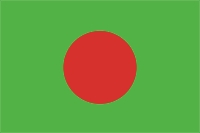Special Program for International Students
GRADUATE COURSE IN EARTH SCIENCE
& GEOENVIRONMENTAL SCIENCE
Current MEXT students
Kabir Md. Fazle (Bangladesh)
Email: fazlekabir @gmail.com
Thesis title: Petrological study on eclogites in the Sambagawa metamorphic belt, central Shikoku, Japan.
Supervisor: Prof. Akira Takasu (2004-2006).
The Sambagawa belt is an elongate belt of relatively high P/T metamorphic rocks that stretches throughout SW Japan for a length of approximately 800 km. To the north the Sambagawa belt is bounded by the Ryoke belt, which is characterized by high T/P metamorphism. Together these form perhaps the best-known example of paired metamorphic belts. The boundary between the Ryoke and Sambagawa belts is a major strike-slip fault, the Median Tectonic Line (MTL), which is associated with ancient left-lateral and recent right-lateral motion. The main rock types of the Sambagawa belt are mafic schist and meta siliciclastic rocks, which can be further divided into common graphitic metapelites, metapsammites and rare metaconglomerates. The mafic schist and meta siliciclastic rocks are associated with minor amounts of manganiferous quartz schist derived from chert. Marble is relatively uncommon in the Sambagawa belt.
Eclogites in the Sambagawa belt have two modes of occurrence, firstly as eclogites occurring in large-scale tectonic blocks, and secondly as eclogites occurring in eclogitic basic schists. Most eclogites reported from central Shikoku occur within large-scale tectonic blocks, and consist of coarse-grained garnet and omphacite. A fault relationship is frequently recognized between the tectonic block and coherent Sambagawa schists of the epidote amphibolite facies. The tectonic blocks are obviously distinguished from the coherent Sambagawa schists in the field. The second type of eclogites occurs in schists containing minor garnet and omphacite assemblage (eclogitic basic schists). The eclogitic basic schists are similar in texture to the coherent Sambagawa schists.
The objectives of my research are as:
- Petrological study to classify the metamorphic stages of the eclogites and related high-P metamorphic rocks based on their texture and structure.
- Analysis of chemical compositions of the constituent minerals to determine the P-T paths of the metamorphic rocks.
- Geochemical study to determine the protolith of the metamorphic rocks.
- Discussion of the origin and the metamorphic history of the eclogites and related rocks.
- Discussion on the tectonics of the Sebadani area in the Sambagawa metamorphic belt, central Shikoku, Japan.


